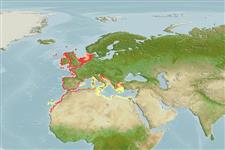Environment: milieu / climate zone / depth range / distribution range
Ökologie
seewasser demersal; tiefenbereich 3 - 50 m (Ref. 130224). Subtropical; 59°N - 20°N, 19°W - 36°E
Eastern Atlantic: North Sea to the Mediterranean, Morocco and Madeira. Reported from the Canary Islands (Ref. 3397).
Size / Gewicht / Alter
Maturity: Lm ? range ? - ? cm
Max length : 27.7 cm TL Männchen/unbestimmt; (Ref. 128593); common length : 10.0 cm TL Männchen/unbestimmt; (Ref. 4645); max. veröff. Gewicht: 166.17 g (Ref. 128593)
Body elongate. Coloration grey-brown on the back and silvery-white on the sides. No spines in front of the eyes (Ref. 35388).
Littoral and benthic, on sandy, muddy or gravelly bottoms, from a few meters to about 150 m (in winter). Rest on the bottom, often buried with eyes and tip of first dorsal fin exposed. Considered as the most dangerous of the European weevers, both for its poison and for its frequent occurrence very near to beaches (Ref. 4675). There are venom glands on the first dorsal fin, which is totally black, and on the gill cover (Ref. 6790). Also Ref. 57406.
Life cycle and mating behavior
Geschlechtsreife | Fortpflanzung | Ablaichen | Eier | Fecundity | Larven
Roux, C., 1990. Trachinidae. p. 893-895. In J.C. Quero, J.C. Hureau, C. Karrer, A. Post and L. Saldanha (eds.) Check-list of the fishes of the eastern tropical Atlantic (CLOFETA). JNICT, Lisbon; SEI, Paris; and UNESCO, Paris. Vol. 2. (Ref. 6790)
IUCN Rote Liste Status (Ref. 130435: Version 2024-1)
Nutzung durch Menschen
Fischereien: weniger kommerziell; Sportfisch: ja
Tools
Can't connect to MySQL database fbquizv2. Errorcode: Too many connections
